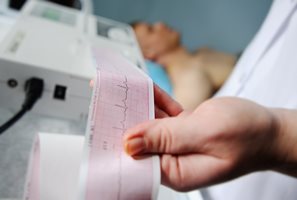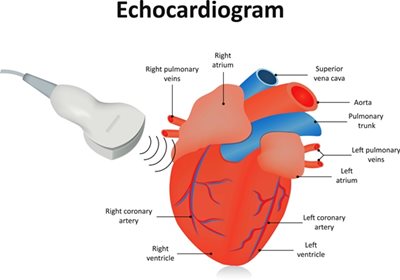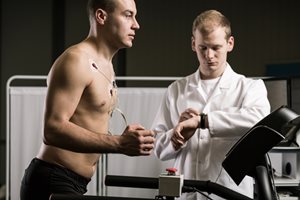There are various types of tests we can perform to accurately diagnose a heart arrhythmia, many of which will depend on your individual medical history, current symptoms, and physical examination.
All of these tests have one thing in common: they are designed to provide electrophysiologists at Valley with the best possible opportunity to diagnose your arrhythmia and formulate an effective treatment plan.
In general, two main types of tests assist in that diagnosis – those that monitor the arrhythmia and those that can actually initiate your arrhythmia. These can include:
In-Office Arrhythmia Tests
Electrocardiogram (ECG)
 This is probably the first test you’ll have when you come to see us in the office. An ECG is a painless, noninvasive test during which sensors (electrodes) that can detect the electrical activity of your heart are attached to your chest and sometimes to your limbs. An ECG measures the timing and duration of each electrical phase in your heartbeat. The results are recorded on strips of paper, called tape, and can provide us with actionable information about your arrhythmia.
This is probably the first test you’ll have when you come to see us in the office. An ECG is a painless, noninvasive test during which sensors (electrodes) that can detect the electrical activity of your heart are attached to your chest and sometimes to your limbs. An ECG measures the timing and duration of each electrical phase in your heartbeat. The results are recorded on strips of paper, called tape, and can provide us with actionable information about your arrhythmia.
 Echocardiogram
Echocardiogram
This noninvasive test is designed to evaluate your heart’s function. In it, a hand-held device called a transducer is placed on your chest and uses sound waves to produce images of your heart's size, structure and motion.
Stress test
 Some types of arrhythmia are triggered or worsened by exercise. During a stress test, you'll be asked to exercise on a treadmill or stationary bicycle while your heart activity is monitored. If we’re evaluating you to determine if coronary artery disease may be causing the arrhythmia, and you have difficulty exercising, then we may use a drug to stimulate your heart in a way that mimics exercise.
Some types of arrhythmia are triggered or worsened by exercise. During a stress test, you'll be asked to exercise on a treadmill or stationary bicycle while your heart activity is monitored. If we’re evaluating you to determine if coronary artery disease may be causing the arrhythmia, and you have difficulty exercising, then we may use a drug to stimulate your heart in a way that mimics exercise.
At-Home Arrhythmia Monitoring Tests
Holter Monitor
This portable ECG device can be worn for one or more days to record the electrical activity of your heart as you go about your routine. Learn more about Holter monitoring.
Event Monitor
If your arrhythmias only happen from time to time, you must keep this portable ECG device nearby, attaching it to your body and pressing a button when you have symptoms. This lets us check your heart rhythm at the time of your symptoms. Learn more about event recording.
External ECG Loop Monitor
A looping memory monitor is a small device about the size of a pager that can be programmed to record your ECG for a period of time, such as 5 minutes. You must push a button to activate it, and it stores your ECG for the period before and during your symptoms. For example, if you faint and push the button after you recover, it will record your ECG during the time you felt faint and passed out, and right after you pushed it.
Implantable Loop Recorder (ILR)
This device is implanted under the skin in the chest area and accurately detects abnormal heart rhythms, helping us to diagnose and determine a treatment course for your specific arrhythmia. Learn more about ILRs.
Smartphone-Based Arrhythmia Monitoring
Many of us are accustomed to using our smartphones to track our activities, steps, or calories. Using them for arrhythmia monitoring is another leap for ECG utilization and arrhythmia detection. Rhythm strip generating smartphone products (Kardia Mobile by AliveCor and ECG Check by Cardiac Designs) are more powerful at arrhythmia detection than wearable monitors. These products, which have been studied in a variety of situations, rely on an external device with metal sensors to create a rhythm strip, which can then be converted to a PDF and emailed to your doctor. As it seems that almost everyone these days has a smartphone, this is creating a major paradigm shift in rhythm detection and monitoring. Learn more about smartphone-based arrhythmia monitoring.
Specialized Arrhythmia Testing
If no arrhythmia reveals itself with the monitoring tests, we may try to bring on an arrhythmia using one of the following tests:
- Tilt table test – We may want to perform this test if you've had fainting spells. In a tilt table test, we monitor your heart rate and blood pressure as you lie flat on a table, after which the table is tilted as if you were standing up. We observe how your heart responds to the change in angle
- Electrophysiological testing – In this test, we thread thin, flexible tubes (catheters) with electrodes at their tips through your blood vessels from a blood vessel in your groin area to a variety of spots within your heart. Once they’re in place, the electrodes can record the spread of electrical impulses through your heart. During the test, we can also evaluate the effect of different medications on your arrhythmia. We can also use the electrodes to stimulate your heart to beat at rates that may trigger – or stop – an arrhythmia. This lets us see the location of the arrhythmia and what may be causing it.

